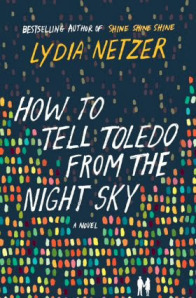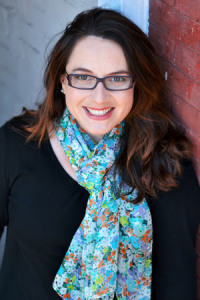Author Interview: Dreams And Destiny Intertwine In Lydia Netzer’s Latest Novel
 I am so honored to have Lydia Netzer on WFW again. Lydia is one of the most courageous and creative novelists I know. She’s generous with her advice and her insights, and never fails to same something worth listening to—and repeating. I wanted this interview with Lydia to be a little different, just to do a mid-summer shake-up! Below, Lydia shares with us not only the the origin of her latest book, HOW TO TELL TOLEDO FROM THE NIGHT SKY, but how she involved dream research in the writing, and what it all means to her.
I am so honored to have Lydia Netzer on WFW again. Lydia is one of the most courageous and creative novelists I know. She’s generous with her advice and her insights, and never fails to same something worth listening to—and repeating. I wanted this interview with Lydia to be a little different, just to do a mid-summer shake-up! Below, Lydia shares with us not only the the origin of her latest book, HOW TO TELL TOLEDO FROM THE NIGHT SKY, but how she involved dream research in the writing, and what it all means to her.
Please welcome my dear friend Lydia Netzer to WFW!
Amy xo
Dreams And Destiny Intertwine In Lydia Netzer’s Latest Novel
 Amy: People seem to want to know where writers’ ideas come from. (I like to say mine come from Target.) But — what I want to know is what came first when you conceived How To Tell Toledo From The Night Sky — a character? a scene? the main idea?
Amy: People seem to want to know where writers’ ideas come from. (I like to say mine come from Target.) But — what I want to know is what came first when you conceived How To Tell Toledo From The Night Sky — a character? a scene? the main idea?
Lydia: Thirteen years ago, I was sitting with my friend Kristen in her mom’s living room, and we were watching our kids playing with blocks and they were so incredibly adorable. They were one at the time, so of course we had their entire lives planned out — they would grow up and fall in love and marry each other, so we could be their in-laws, and holidays and grandparenting would be so much fun! I think all mom friends have had that fantasy at some point. But as we sat there musing, and laughing about how we could raise them up separately to be perfect for each other (she’s west coast, I’m east coast), I just kept thinking how interesting a story it would make if someone really tried to do that for real. As I developed the idea into the plot of a novel, I had to ask a lot of questions — what would motivate a pair of friends to really do this to their kids, how would they go about it, and of course what could go horribly wrong? We are talking about a novel after all — so disaster is a requirement.
Amy: Where you were when the idea TOLEDO hit you over the head?
Lydia: One of the ideas for the book came to me in an airplane! I was flying in an airplane at night, and I was gazing down on the lights of towns and roads, headlights, like you do. I don’t remember what city exactly I was flying over when I realized that the lights of the cities below me, connected by roads, were like the lights of the stars above me, connected in constellations. It was sort of a weird moment, because I think a lot about Aristotle’s cosmology, the crystal spheres, and the scientifically outdated but still philosophically relevant idea that things in the heavens are perfect by definition and things on earth are messy and damaged. It’s one of the most important elements of the book, and it ended up inspiring a pivotal scene for my main character.
Another idea in the book is that sleep is like practice for death, and dreams are like practice for the afterlife. I don’t know when I started thinking about this, but the process of falling asleep has always kind of creeped me out. I think if aliens ever visit this planet, our habit of going into a dark room, flattening ourselves, shutting our eyes and completely losing control of our minds for eight hours might raise some alien eyebrows. It’s so odd to me that we know so little about such a huge part of our lives — what happens in dreams, and what is the transition between waking and sleeping? And that’s not even to mention the mystery of death, the transition between life and death, and what happens after. This novel is a love story, but it’s also an exploration of these ideas.
Amy: In Toledo, the characters “meet up” in dreams. What fascinates me is that Irene has control of her dream landscape. I know this is possible, at least to some extent, because in real life, it’s something I can do. What kind of research did you do on lucid dreaming to make the character’s experience real? And, do you experience lucid dreaming?
Lydia: I’ve been actively trying to control my dreams ever since I started working on that element of the novel. I researched different methods and ideas lucid dreaming. The main thing is being able to stay in your dream when you realize it’s a dream. Most people, as soon as they realize they’re dreaming, fall out of the dream and either wake up or move on to another dream. So that moment when you realize you’re dreaming is very important, and most theory on lucid dreaming focuses on that. For example, one theory is that you should count your fingers regularly throughout the day, or look at a clock with a dial, or open a book to a certain page. If you make this habitual, the theory is that you’ll find yourself doing it in a dream. But in the dream, you’ll see three fingers, or a blank dial, or an unfamiliar page, and you’ll know you’re dreaming.
From there the trick is to stay in the dream, take control, and not let your awareness slip away. This is hard for me, but I’ve been able to do it a few times in the last year. The first time we during one of those “I’m naked in public, crap!” dreams, and I realized I was dreaming, and was able to dream myself into clothes. Yes, it was a hideous gray unitard, but it covered me. The second time, I was reaching for a crate of lettuce in a farmer’s market, and I couldn’t reach it. Realizing I was dreaming, I made the crate come toward me.
At this point I almost gave up on the whole lucid dreaming thing, because after watching “Inception” I was frankly expecting a bit more from my subconscious than a levitating lettuce crate. I mean come on. Finally I was able to fly in a lucid dream, all except for my head, which dragged along the ground — typical! My characters meet in dreams, find answers in their dreams, and create their own realities. It’s almost like what writing a novel is for me — a way to work out questions in your imagination, to create a world that obeys your rules. Yet there’s always that element of lunacy in dreaming, that sense that you’re not in complete control. And that’s the magic of writing for me too — I’m always excited to see what will happen.
 Lydia Netzer’s first novel, Shine Shine Shine, was a NYT Notable Book, a Target Book Club pick, and was a finalist for the LA Times Book Prize. Her new novel, How to Tell Toledo From the Night Sky, was just released on July 1. Entertainment Weekly calls it, “a lovely summer valentine.” She lives in Virginia with husband and two kids, and their dogs and horse.
Lydia Netzer’s first novel, Shine Shine Shine, was a NYT Notable Book, a Target Book Club pick, and was a finalist for the LA Times Book Prize. Her new novel, How to Tell Toledo From the Night Sky, was just released on July 1. Entertainment Weekly calls it, “a lovely summer valentine.” She lives in Virginia with husband and two kids, and their dogs and horse.








Women's Fiction Writers
- Amy Sue Nathan's profile
- 543 followers



